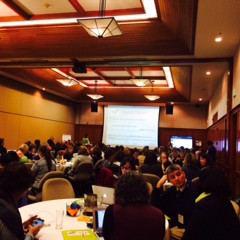By Tom
First breakout session: Navigating the Systems of STEM, by Al Gonzalez, who teaches middle school in Chimacum, Washington. He’s what you might call a “Techie.”
He began the session by pointing out the fact that most adults now travel to events like this conference with more than one internet-compatible device.
Al acknowledged that teachers are overwhelmed right now, but asserts that a lot of what we do overlaps with other stuff. (Think TPEP and Common Core) He also encouraged us to use technology to ask for help, in particular; places like Yahoo Groups. He uses practically every conceivable form of social media to connect with his students, their parents and other teachers. Technology, of course, can be fickle. To wit: most of the activities Al had planned were based on-lined; yet the room had limited connectivity. Fortunately, Al had plenty of “Plan Bs.”
Al talked about “branding.” Teachers need to establish and maintain their digital identity. We need to think about how we look when someone googles our name. Blogging, Facebook, Twitter and all the rest are a part of our “brand.”
Another aspect of technology is “curating.” Curating refers to the collecting and rendering of the vast amount of information that’s out there. His favorite collecting tool is something called “Feedly.” which he uses to collect information from a vast amount of teacher bogs and other sources.
Al spent some time talking about advocacy. Starting at the classroom level, he invites legislators into his room to co-teach or just visit. And then he blogs about it. At the district level, he makes sure that school board members, as well as the superintendent, know what’s going on in his classroom. He videotapes a lot and posts on YouTube, showing what his students are doing in his room. We had a nice discussion of various platforms for displaying student learning on-line.
The last thing Al discussed was grant writing. His best advice is to contact district administrators and have them forward grant proposals his way. He reasons that grants proposed to teachers are going to be exponentially more competitive, since there are so many teachers. Administrators, on the other hand, are less numerous; the grants they have access to are therefore less competitive. He’s raised nearly $300,000 by writing grants, most of which went directly into his own classroom.
This was a fun session. All is obviously way farther down the road than most of us in terms of implementing technology into his classroom.



 han a confusing five-way stop. Everyone yields and everyone turns right. It’s consistent and predictable.
han a confusing five-way stop. Everyone yields and everyone turns right. It’s consistent and predictable.